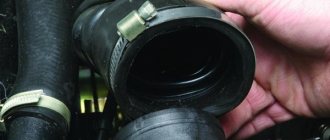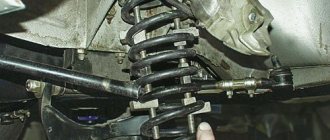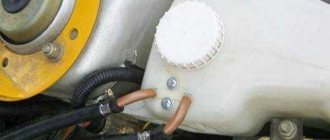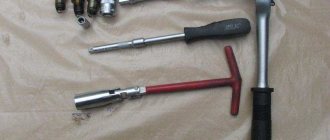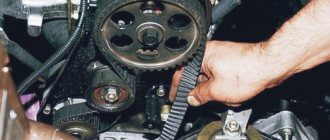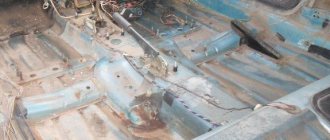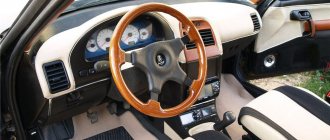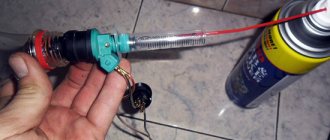Professional MAF cleaners allow you to clean and restore the functionality of the mass air flow sensor and air pressure sensor without damaging the sensitive element itself. When choosing a non-special cleaning agent, it is necessary to take into account its composition, since the air sensor itself is very susceptible to destruction by chemically aggressive substances.
Of all the products on the market specifically designed to remove carbon deposits from the MAF, DTVV or DDVK sensors, five cleaners turned out to be the most popular and effective. The results of their action have been proven in practical use by many car owners. The rating of air flow sensor cleaners was compiled according to reviews. To make the right choice, study in detail their characteristics, composition and indications for use.
| Name of the air flow sensor cleaner | Features of the product | Volume in ml | Price as of summer 2022, Russian rubles |
| Liqui Moly Luftmassensor Reiniger | Removes stubborn stains and evaporates quickly | 200 | 950 |
| Kerry KR-909-1 | Good performance at an affordable price | 210 | 160 |
| Hi Gear Mass Air Flow Sensor Cleaner | Used for professional cleaning in car services | 284 | 640 |
| CRC Air Sensor Clean PRO | A good option for cleaning diesel car sensors | 250 | 730 |
| Gunk Mass Air Flow Sensor Cleaner | Can be used for MAF and IAT sensors; if heavily soiled, it will have to be reused. Has a rubber seal | 170 | 500 |
Compound
Designed to effectively remove oil, dirt, small fabric fibers and dust from the sensor without damaging it. The main components of MAF sensor cleaners are:
- Hexane, or its rapidly evaporating derivatives.
- An alcohol-based solvent (usually 91 percent isopropyl alcohol).
- Special additives that manufacturers (the main one is the Liqui Moly trademark) use to protect their copyrights. They mainly affect smell and density.
- Carbon dioxide as a retardant for the composition in a can.
The mixture is usually sold in the form of an aerosol, so the substances must be highly dispersed, not irritate the skin and not have a harmful effect on the environment. The physical and mechanical characteristics of the most commonly used compounds (for example, Luftmassensensor-Reiniger from Liqui Moli) are:
- Density, kg/m 3 - 680...720.
- Acid number – 27…29.
- Ignition temperature, º C – not less than 250.
CHECKING THE FUNCTIONAL STATE OF THE DMRV
To determine that this particular unit is faulty and the mass air flow sensor needs to be washed and repaired, you need to check the mass air flow sensor with a multimeter.
A multimeter, also known as a tester, is an electronic device that can be purchased at any auto store at a price of 400-600 rubles for the simplest models (their functionality will be quite enough for us). It is not inexpensive and will be useful in the garage many times - you can use it to check any sensors and electronic systems of the car.
The serviceability of the mass flow sensor is checked as follows:
- We switch the tester to voltmeter mode and set the upper limit of sensitivity to 2 Volts;
- We connect the multimeter probes to the yellow and green wires (they are located in the sensor connection socket);
- We activate the ignition (there is no need to start the engine) and look at the tester reading.
If the tester testifies that the voltage between the yellow and green contacts fluctuates in the range from 0.0099 to 0.02, then everything is fine with the unit.
If the device is dying due to wear or contamination of sensitive parts, the tester will show a maximum voltage of 0.03 V, in which case it is necessary to clean the mass air flow sensor on the VAZ 2114.
In the case when the multimeter readings are much higher than the upper voltage limit, in the range of 0.045-0.5 V, or significantly less than the minimum - 0.09-0.095 V, the probability that flushing the mass flow sensor will give a result is approximately 50%.
Checking the mass flow sensor with a multimeter is not a dogma, there are other methods
There is another simple method to check the functionality of this unit, which can be used if you do not have a multimeter. Just remove the mass air flow sensor and close the air duct valve, start the fourteenth and run it at 2 thousand rpm. If you feel that in the absence of a sensor the car behaves much better on the road, this is the problem.
How to use?
Cleaning the air flow sensor must be performed whenever the air filters are changed. The sensor itself is located in the air channel between the filter box and the throttle body. Using a special tool, the device is carefully disconnected from the electrical connectors.
Some brands of cars are equipped with mechanical flow meters. They do not have measuring wires, and therefore are less sensitive to the thoroughness of dismantling.
Next, 10 to 15 sprays are applied onto the wire or sensor plate. The composition is applied to all sides of the sensor, including terminals and connectors. Platinum wires are very thin, so they cannot be wiped. After the composition has completely dried, the device can be returned to its original place. A good spray should not leave marks or streaks on the surface of the air flow sensor.
Troubleshooting methods
There are several options for troubleshooting the device:
- Replacing the sensor. The surest way to ensure normal system operation is to install a known working controller.
- Check the connection of the regulator, as well as the functionality of the electrical circuit. It is very rare, but it happens that the regulator refuses to work normally due to oxidation of the contacts on the connector. In this case, you can try to disconnect the sensor and clean the contacts with an iron brush.
- Rinse the device. This option for restoring performance is considered one of the most popular among our compatriots today. Cleaning usually takes a little time, but you have every chance of restoring the functionality of the regulator. Our resource has already written about flushing the device; detailed step-by-step instructions are presented in this article.
Features of application
The nuances are determined by the brand of car that has a mass air flow sensor. In particular, the choice of installation tools used to unscrew the fasteners depends on this.
You should never use MAF cleaner while the engine is running or the ignition is on. This can cause serious damage to the sensor, so it should only be disconnected when there is no current in the system.
Before spraying, place the sensor on a clean towel. Cleaning must be done so as not to touch any of the sensitive elements with the nozzle of the aerosol head.
To improve the cleaning effect, it is recommended to pre-wash the surface of the air flow sensor. To do this, place the unit in a plastic bag filled with isopropyl alcohol and shake vigorously several times. After drying, apply mass air flow sensor cleaner.
Comments and reviews
At idle it stalls and jerks when driving
Hello! VAZ 2115, 1.6 l, injection mileage 40 t.km. a year ago, when starting from 1500 rpm, it doesn’t troit, after 5 minutes it troits. I restarted it, it doesn’t troit. In the urban cycle, it’s normal. On the highway 90-110, when I release the gas, it troits. Restarts and normal acceleration is sharp. Thank you.
Hello. I have the same problem, fuel consumption has increased from 8 to almost 12, when starting the engine when cold, the speed reaches normal, then immediately drops to 500, then it rises to normal until the car warms up, and when warm, the speed in drive drops to 550 -600 in reverse gear the same, the speed of my car is 800-990
Hello, yesterday the check engine light came on. Connected elm327. I use the open diag program. Error code P0172 (rich mixture). Doesn't start well. The revolutions are floating. Sometimes it just stalls. Is it the DMRV? Or maybe something else?
Cleaning the mass air flow sensor is a procedure necessary to ensure reliable engine operation. Some car enthusiasts believe that the MAF (mass air flow sensor) is a part that cannot be serviced and that if it fails, replacement is necessary. However, practice shows that after cleaning, most sensors can continue to work successfully. In addition, this part is quite expensive. Therefore, the ability to maintain the sensor in working condition not only ensures the normal functioning of the car engine, but also allows you to significantly save money.
Is it possible to clean the air flow sensor with carburetor cleaner?
It is not recommended to use carburetor cleaners for electronic sensors! The chemicals contained in these products can cause irreversible damage to sensitive elements. However, the use of such compositions for cleaning mechanical flow meters is not excluded. However, here too it is better to use specialized substances, for example, budget cleaners offered by the Kerry brand.
It is necessary to warn owners of cars equipped with similar sensors against other errors:
- Cleaning with more active solvents: this may cause deformation of the plastic parts of the sensor itself and its housing.
- Using cleaner brands not recommended by the vehicle manufacturer.
- Cleaning the mass air flow sensor with products that are used to clean the throttle body.
- Reinstall the unit that has not dried after treatment.
A clean sensor can restore 4 to 10 horsepower to the car, which is well worth the time and expense of cleaning. It is recommended to perform such prevention once a year.
When the first signs of a malfunction occur, you should definitely check the mass air flow sensor, and then, depending on the situation, clean or replace the device.
Examination
Now let's talk about how to check our sensor. Today, two main methods of checking the mass air flow sensor are used.
- The engine is tested in operation with the mass air flow sensor disconnected. Simply turn off the power from the regulator and start the motor. When the mass air flow sensor is not present during startup, the electronic control unit turns on the power unit in emergency mode. The speed is adjusted to 1500 rpm. After disconnecting the sensor, drive a few kilometers and evaluate the dynamics and power. If the engine is running normally, then the sensor is the cause of the symptoms.
Instructions for washing the mass air flow sensor
Cleaning the flow meter can be done in a garage; there is nothing complicated about it.
Depending on the car model, the procedure for removing the sensor can be carried out in different ways; consider an example of cleaning with a domestic “Ten”:
- First, you should turn off the ignition and, just in case, reset the battery terminal. Open the hood and find the mass air flow sensor, then disconnect the connector from it. There is a pipe connected to the flow meter; it must be disconnected. Using a wrench, you need to unscrew the screw that secures the device to the air filter, or rather, to its housing.
- The flow meter itself is removed from the corrugation; in the case of the “ten”, an asterisk wrench is required to dismantle the sensor. Use it to unscrew the screws and then remove the device from the seat.
- If, after removal, you notice that there is an oil deposit on the device, you will need to rid the case of this. Any product from those described above is suitable for cleansing. As practice shows, there is no fundamental difference between these means.
- On the sensitive element, usually made in the form of a film, there are several controllers; they are made in the form of a wire and mounted on resin. Using the same cleaning agent, you will need to carefully, not in abundance, spray it on the sensitive element. At this stage, you should act as carefully as possible, since there is a possibility of damage to the film. After the sensitive part has been treated, you need to wait a little until the product takes effect. If there is a lot of contamination, then it may make sense to repeat this procedure once or twice. In order to ensure faster evaporation of the substance, you can use a pump or compressor device. But keep in mind that too much pressure can destroy the sensitive component, so don't overdo it.
Cleaning
Quite often you can avoid replacing the mass air flow sensor by simply cleaning this engine element.
You should do the cleaning yourself in this way:
- Remove the pipe from the mass air flow sensor;
- Now remove the sensor from the pipe. Otherwise, high-quality washing will not work;
- To remove the sensor, arm yourself with sprocket keys in advance. Finding such kits is not a problem;
- Unscrew all the fasteners, remove the sensor from the pipe and assess its external condition;
- Often there are traces of oil deposits on the sensor. The purpose of cleaning is to make the device as good as new;
- Carburetor cleaner is often used to clean the air flow sensor;
- Inside the film there are sensors, which are small wires attached to a special resin. These elements must be carefully sprayed with cleaner so as not to damage the devices;
- Wait a while for the surfaces to dry. To speed up the process, use a can of compressed air;
- It is not uncommon to use alcohol instead of carburetor cleaner, which also works quite effectively;
- Proper cleaning of the mass air flow sensor involves treating the pipes from accumulated debris, dirt and dust;
- Having carefully processed all the components of the removed mass air flow sensor, wait until it dries, and then reassemble it. Cleaning is complete.
Spray cleaning
Statistics show that in about 80% of cases, simple cleaning can return the mass air flow sensor to its previous functionality.
Price issue
80% is not 100. Therefore, sometimes you have to change the sensor. And to replace it, you need to buy it.
There are three price categories for air mass flow sensors:
- Cheap. These are predominantly Chinese products, the price of which is up to 1000 rubles. It is strongly not recommended to purchase such regulators;
- Average. These include sensors from AvtoVAZ, domestic and some foreign analogues. These cost from 1500 to 2500 rubles;
- Expensive. High-quality, reliable, imported air flow sensors, the price of which can reach 5.5 thousand rubles. It’s hard to say how rational it is to buy them. But they will definitely last a long time.
When choosing a new mass air flow sensor, focus not only on the price, but also on the manufacturer. Today, the most popular devices are from Siemens and Bosch. Average in price, excellent in quality.
Step-by-step process
Purchase the required liquid, take a disposable syringe and a flat-head screwdriver. Even if you are a pro and know every crack of your car, still read the instructions again on how to clean the mass air flow sensor on a VAZ 2114. If you opened the hood of your fourteenth for the first time and you feel itchy, pray that everything goes smoothly, while reading the instructions at the same time.
- We opened the hood, found the sensor, removed it (loosen the fastening of the air filter hose with the sensor, unscrew the two nuts with a ten-point socket wrench and voila, done);
- There is a part on the sensor that is screwed to its body with two bolts; it must be unscrewed;
- Inside, we spray the necessary liquid from a syringe onto the sensitive element (you can also rinse the contact system of the block);
- Let it dry.
All that remains is to put everything back in place and start the engine.
Flushing may not help the first time, so don’t get upset and repeat the process. If it still doesn’t help, you’ll have to buy a new air meter.
The mass air flow sensor is a device without which normal engine operation is impossible. Performance on the functionality of the power unit. How to determine if the flow meter is faulty and how to clean the mass air flow sensor - you can find the answers to these questions below.
[Hide]
Replacement
It is not difficult to replace the mass air flow sensor with your own hands, even if you do not have any special skills in car repair. Having checked the condition of the device and determined that cleaning will not help, all that remains is to replace it.
- Place the car on a level surface, lift the hood and remove the negative terminal from the battery.
- Disconnect the sensor connector. We have already talked about its location, so there will be no problems with the search.
- Using a screwdriver, remove the clamping bolt of the clamp that secures the corrugation to the mass air flow sensor.
- The corrugation is removed.
- Using a 10mm wrench, unscrew the two bolts that hold the sensor to the air filter housing.
- After removing the failed oxygen sensor, install a new regulator in its place.
- Screw back a couple of bolts, secure the corrugation and secure it with a clamp.
- Reconnect the connector and return the negative terminal to the battery.
If everything is done correctly and the breakdown is correctly identified, then the engine will return to its previous performance and the error signal on the dashboard will disappear.
Replacing the device
To finally check the result of the repair, go out onto the road, do a test drive and be sure to try to press the gas pedal sharply. If the dynamics and power become the same as before the problems arose, you did everything correctly, and it was the mass air flow sensor that was the culprit of the malfunction.
Every vehicle owner who takes good care of his car and is interested in it knows very well what a mass air flow sensor, or MAF, is. Also, many car enthusiasts know what functions this device performs. At the same time, not every driver knows how to clean the mass air flow sensor. What exactly is this detail and what is its role? This question is relevant for many beginners.
Possible malfunctions of the mass air flow sensor: signs and causes
How to clean and rinse the mass air flow sensor? We will talk about this below, but first, let's look at the signs and causes of device malfunction. The parameters transmitted by the flow meter largely influence the formation of a combustible mixture, which is very important for any modern engine. If the device fails, this may also make it impossible to start the engine.
By what symptoms can you understand that it is time to change or clean the regulator:
- the appearance of the Check Engine indicator on the control panel;
- the fuel consumption of the car has increased;
- The power of the vehicle has decreased significantly; the car now needs more time to gain speed;
- the dynamics dropped, in particular when accelerating;
- the engine does not start, it is possible to start the power unit with great difficulty;
- If the car is idling or stopped at a traffic light, then the crankshaft speed may fluctuate.
When is it time to clean?
But regardless of the type of sensor, over time it begins to function incorrectly due to contamination - the platinum measuring elements become covered with dust. Therefore, the question of how to clean the mass air flow sensor will always be relevant.
Why does this happen? The main reason for sensor contamination lies on the surface - the unsatisfactory condition of the air filter. If the filter element is of poor build quality, then it is not able to trap microscopic particles of dirt and dust that settle on the sensing element of the mass flow sensor.
As a result, the device is not able to accurately measure the amount of air and sends incorrect data to the ECU. It's not hard to imagine what this might lead to. Here we gradually approach some characteristic signs that may indicate that the sensor is clogged and needs to be cleaned:
- The need to clean the mass air flow sensor on a VAZ or other cars arises when the engine idles intermittently, in some cases they are too high - up to 1500.
- The car may jerk and have difficulty accelerating.
- Sometimes the engine does not start at all.
- Increased fuel consumption - sometimes up to 15 liters per 10 km.
- Check Engine light on the dashboard.
However, the above signs do not always accurately indicate contamination of the air flow sensor. A variety of situations can arise, and among them is one when the sensor itself is fine, but the fault lies in the hose that connects the device to the module.
In other words, although there are many obvious signs that a particular part of the car is faulty, they can indicate any other problem.
Symptoms and consequences of failure of the mass flow sensor
This important part controls the amount of incoming air as well as gasoline. The mass air flow sensor transmits all information to the electronic control unit. Based on them, the controller can mix fuel with air in precise proportions. If it malfunctions, then due to a poor-quality mixture, the dynamics of the car will deteriorate, fuel consumption will increase, and the engine will significantly lose power.
The main element of the sensor is a resistor. During operation, resins accumulate on its surface, which often cause malfunctions during the operation of the mass air flow sensor. The degree of contamination of this device directly depends on the cleanliness of the air filter.
The following symptoms indicate problems with the sensor:
- intermittent engine operation without load;
- increased idle speed;
- excessive “thoughtfulness” when accelerating the car, jerking, twitching, failures;
- problems starting a cold engine;
- a sharp increase in fuel consumption.
If one or more signs appear, then it becomes necessary to further check the sensor. For this purpose, you can use a multifunction tester (multimeter).
The check must be carried out in the following order:
- First you need to switch the device to voltmeter mode, setting the upper sensitivity limit to 2 Volts.
- Install the device probes on the yellow and green wires, which are located inside the sensor connection socket.
- Start the ignition.
Normally, the voltage should be 0.0099-0.02 Volts. If this value is 0.03 Volts or higher, then the mass air flow sensor needs to be cleaned.
If you don’t have a voltmeter, you can check the functionality of the device in a simpler way. To do this, you need to remove the sensor and close the air duct damper. After this, start the engine and let it run at 2000 rpm. If under such circumstances the power unit works better, then the problem is in the sensor. It needs to be cleaned immediately.
Sensor check
To accurately verify that the sensor is faulty and understand whether the mass air flow sensor on the VAZ-2114 needs to be cleaned or not, whether it needs cleaning or whether you will have to go to the store for a new mass air flow sensor, you will need a multimeter known to all radio amateurs:
- The device is switched to voltage measurement mode (voltmeter).
- Set the limit to 2 V.
- There are two wires in the sensor connector - yellow (it goes to the ECU) and green (connects to ground).
- The voltage is measured between these wires, and only the ignition should be turned on.
- Now all that remains is to look at the instrument readings.
If the measurement result is 0.99-0.02, the sensor is working. If the upper threshold is exceeded to 0.03, the mass air flow sensor needs cleaning and the sooner the better. In the case when the measurements are less than the lower limit (0.95) or the upper limit is very high (0.05), then the chances of a successful outcome are 50/50. That is, either cleaning will help and the sensor will function properly again, or you need to buy a new device.
In addition to this, you can understand whether to clean the mass air flow sensor on a VAZ-2110 or not by using one more method when you don’t have a multimeter at hand. Disconnect the sensor, then start the engine, raise the speed to 2000 and drive for a while. If at this moment there are obvious changes, the car has become more dynamic, then the sensor is definitely dirty.
Sensing element of the air flow sensor
The most common cause of sensor failure is a dirty element. To resolve the problem, it is recommended to check it. To do this, you need to disconnect the mass air flow sensor from the air filter assembly and visually inspect it. If the sensing element is dirty, it may be serviceable, but contamination introduces errors into the measurement mode. Sensor check:
- Identify the terminals on the MAF sensor itself that correspond to the signal wire and ground.
- Connect one measuring probe to the signal and the other to ground on the MAF electrical connector. Polarity doesn't matter.
- The indicator should be 0 Ohm or close to this value. If the device displays infinite resistance, most likely the mass air flow sensor element is faulty.
- Visually inspect the sensor.
Set the meter to the continuity or low setting on the ohm scale.
Liqui Moly
How to clean the MAF sensor? One option is cleaning fluid from Liqui Moly. The company is known to many car enthusiasts as a manufacturer that makes only high-quality products for cars. In addition, the ratio between reliability and price is at an optimal level. As for the use of liquid for cleaning the mass air flow sensor, most vehicle owners have already become convinced of its effectiveness. This has not been proven by a single procedure. And if the sensor is in working condition, then even after cleaning it will last no less.
The liquid can be used for both diesel and gasoline engines.
Purifier selection options
How to clean the flow meter? The modern market offers many products for cleaning regulators; let’s look at the most effective options:
- Liqui Moly. This manufacturer, as you know, produces not only cleaning products, but also motor and transmission oils, as well as other types of liquids. If you believe the official information provided by the manufacturer, then this product belongs to the high-quality category. Accordingly, the cost of such a MAF cleaner will also be high. In fact, Liqui Moly cleaners cope with their tasks quite effectively - this product perfectly removes dirt from the sensor. If the flow meter was in working order at the time of cleaning, then after that it will work for a long time. The use of Liqui Moly is relevant in both gasoline engines and diesel power units.
- Alternatively, you can use alcohol to clean the device. This method is considered one of the oldest, but nevertheless the most effective. Due to its chemical properties, alcohol is good at removing clogs that accumulate on the sensitive component of the air flow sensor. Despite its effectiveness, today this method is not used so often and is usually used by unscrupulous technicians at service stations. The client pays for a special substance, for example, Liqui Moly, and in fact the cleaning is carried out using alcohol.
- The next option is fluid for carburetor engines. This option is considered one of the most effective and frequently used. Using carburetor fluid, you can effectively clean it, and as practice shows, such a product allows you to remove all contaminants.
- Another product sold in spray form is Liquid Key. This cleaner is used to remove all kinds of contaminants, not only from the flow meter, but also from other mechanisms and components.
- A universal tool for performing many tasks is WD-40. This liquid is used by our compatriots to clean all kinds of components, remove rust, get rid of squeaks, etc. Not so long ago, our car enthusiasts began to use it to clean flow meters (the author of the video is the Gen channel MB W140 Germany).
Alcohol
We can say that this is an old-fashioned method, which at the same time will never lose its relevance. Alcohol can effectively break down dirt and blockages. About 20 years ago, the question of how to clean the mass air flow sensor was mainly solved with the help of alcohol, and this method was held in high esteem by many drivers, but now they are trying to resort to it less and less.
Nevertheless, it is relevant in cases where the car owner needs to invoice for washing with special means. Unfortunately, such disappointing practice is not uncommon at many service stations.
What is the best way to flush the air flow sensor?
In fact, there are not many cleaning compounds that can be used to clean the air sensor - all the others will simply ruin it (see section above).
Therefore, the question: what is the best way to flush the air flow sensor can be answered quite specifically:
- pure medical ethyl alcohol that does not contain any impurities;
- carburetor cleaner (does not contain acetone);
- spray WD-40.
WD-40
At the same time, medical alcohol can be used either 96 degrees or diluted with distilled water in a ratio of 1 to 5.
Liquid key
This product from a domestic manufacturer is sold in the form of a spray. It is designed to get rid of frozen contaminants on various components and assemblies of vehicles.
Absolutely every car enthusiast is familiar with this product, regardless of experience. In addition, all other people who are not directly related to cars know about it. Over the course of its existence, WD-40 has proven itself to be excellent, and there is no doubt about its effectiveness.
For this reason, it is used not only to remove “deposits” from bolts, but also to clean the mass air flow sensor.
Which cleaner should you choose?
If you decide to clean the mass air flow sensor yourself, you need to choose the right product:
- Liqui Moly. To clean the regulator, you can use Liqui Moly liquid. Liqui Moly is known for all its automotive products. Products from the manufacturer Liqui Moly are characterized by high quality, as well as a considerable price. The liquid mass air flow sensor cleaner Liqui Moly is an effective product in practice. As practice and reviews from car enthusiasts show, Liqui Moly allows you to effectively get rid of contaminants and if the air sensor is in working condition, after cleaning it can work for a long time. This product is suitable for both petrol and diesel units. The cost of Liqui Moly today is about 12 USD. e.
- Alcohol. You can clean the air sensor the old fashioned way - using alcohol. Alcohol allows you to effectively break down dirt and blockages. The use of alcohol was relevant twenty years ago; today this method is rarely used. To deceive the car owner and bill him for flushing the regulator with a cleaning agent. This practice occurs frequently at our service stations.
- Liquid for cleaning carburetors. One cheap option to clean the device is to use carburetor cleaner. The cost of one cylinder is about 1.2 dollars. If you believe the reviews of car enthusiasts, this analogue is no less effective than Liqui Moly, while its cost is ten times lower.
- "Liquid Key" Also a domestic product, sold in the form of a spray. The product is intended to rid various vehicle components and assemblies of frozen contaminants.
- WD-40. Many motorists have such a tool. In practice, WD-40 has long shown its effectiveness, so many car enthusiasts use it for these purposes. It can also be used to clean the air sensor (video author - Pavel Ksenon).
How to properly clean the air flow sensor
Let's consider the procedure for cleaning the mass air flow sensor using the example of a car of the 10th family - VAZ-2110:
- Turn off the ignition.
- Disconnect the connector from the mass air flow sensor.
- Remove the sensor itself by unscrewing the bolts that secure it to the air filter housing. Depending on the car model, disabling the mass air flow sensor may vary.
- The sensor is removed from its place, otherwise its cleaning will not be effective.
- On the device itself there is an area with two bolts - these should also be unscrewed.
- The selected cleaning agent is drawn into a syringe and then sprayed onto the sensitive element. At the same time, if necessary, you can wash the block with contacts.
- Give time for everything to dry.
- Assemble the sensor and install it in place.
To make drying faster, you can use a compressor only at minimum pressure. If the sensitive element is heavily soiled, the procedure should be repeated several times.
But even in this case, washing does not always give the desired result, and you just have to go to the nearest store for a new mass air flow sensor.
What kind of device is this?
Such an element is present in any modern car, since the era of carburetor engines has passed and an electronic control unit (ECU), or controller in other words, is responsible for many operations. Many drivers even call him “the brain.”
The mass air flow sensor is used to measure the amount of air supplied to the engine. However, this device does not measure its volume, but only determines how much mass passes per unit of time, sending data to the ECU. In turn, the controller “understands” how much air has entered the cylinders at each moment of time, and depending on this, adjusts the fuel supply. As a result, the engine runs smoothly and without interruption.
Beginners may be interested not only in whether the mass air flow sensor can be cleaned, but, in fact, where it is located. Typically, this device is located in the area between the air filter housing and the pipe that goes to the throttle valve. It is equipped not only with gasoline, but also with diesel power units.
Additional manipulations
It is now clear how to clean the mass air flow sensor, but this procedure alone does not end everything; it is necessary to perform a number of additional and necessary manipulations. And you need to do this before installing a clean device. And while the cleaning agent is drying, it’s time to work on the air pipe. It is worth carefully inspecting it for integrity. And if the condition is unsatisfactory - there are cracks and other damage, then it should be replaced.
As experts note, before installing the mass air flow sensor, it is advisable to replace the filter element. You should also check the condition of the rubber seal. Here it is important to pay attention to how tightly it fits, otherwise it will not be possible to avoid the suction of outside air, which is flooded with various contaminants. As a result, cleaning will be required again, and in a fairly short time. Or it will lead to its failure altogether.
Do-it-yourself DMRV restoration
In general, my mass air flow sensor began to die, the voltage at the ignition is 1.035V - and this is a dying state, and this in general is a reading of as much as 1.2 liters of air! ideally it should be 0.996v. As everyone understands, a mass air flow sensor is nothing more than a normal resistance that changes depending on the heating, the incoming air flow blows on the sensor, thereby reducing the resistance and increasing the voltage on the sensor, the more air -> the colder the sensor -> the less resistance -> the more voltage = and by voltage we determine how much air the engine has consumed, we spray fuel there in a ratio of 1: 14.7. Over time, the sensor, I call it “burning out”, loses resistance, then our ingenuity comes to us, what can we do? 1. put a tuning resistor on the 4th and 5th wires and compensate for the lost resistance. (never tested, but in theory it should work) 2. Force your brains to think about a higher voltage and a smaller amount of air. (everyone remembers what the wise men told us - we need to install the mass air flow sensor the same as before (I’ll explain below)). At first I wanted to go along the first path, but I didn’t want to mess with the wires, so we go along the second. We will adjust the voltage values to the amount of air. We take the wonderful program “Max air flow sensor corrector v.1.0”, open our firmware for it and look at the voltage values = amount of air
Now remember those sages, and all because different mass air flow sensors have different meanings for the incoming air, we will return to the sages later, but for now to our sheep.
Now let's turn to typical parameters, for example I have January 7.2
Please note that at idle speed XX 800 the engine should breathe only 8 kg of oxygen, which, coupled with my sensor, showed 11 or even 12 kg, naturally it also gave 13 kg of gasoline, and there was only 8 kg of air => here you go and a rich mixture, excessive fuel consumption and engine shaking.
This means that in the DMRV program I open the firmware and look in the third column for the value that our engine consumes at idle, let’s take the figure 11.7 kg/h and adjust the 4th column so that according to the parameters it would be 8.3 kg/h
After saving the firmware, upload it to your brain))))
Now at idle I have 8 kg of air at 3000 XX - 26 kg/h of air (remember the standard parameters), the engine has stopped shaking. Consumption has decreased slightly.
Ps back to the sages, if you find the same mass air flow sensor as you had, just open the firmware, select your new mass air flow sensor, save, upload.
Z.Y. There is a Bosch sensor, it showed well over 1.035. It was never washed (they just changed it to a new one) This sensor lay for several months near the grain crusher, when the crusher is working, vibration is felt near it, after several months of “massage” it began to show normal readings! Now we need to repeat this experiment) now the reading is 1.01. Can anyone repeat it? With “vibration cleaning” of the mass air flow sensor.
The mass air flow sensor is one of the most expensive measuring instruments in the VAZ 2114. The main reason for its failure is contamination of the sensitive contacts. With the right skill, they can be cleaned, thereby bringing the sensor back to life and depriving yourself of the need to spend 2.5-3 thousand rubles on purchasing a new device.
From this article you will learn how to clean the mass air flow sensor, what products are best to use for this and what tools are needed to clean the mass air flow sensor of a VAZ 2114.
